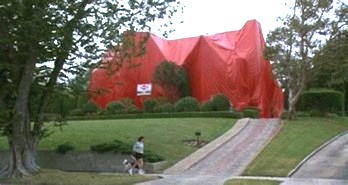by Douglas Messerli
Bruce Wagner
(screenplay, based on a story by Paul Bartel and Bruce Wagner), Paul Bartel
(director) Scenes from the Class Struggle in
Beverly Hills / 1989
Bartel’s dark and witty
comedy of 1989 begins with a huge orange tent being draped over what is
supposed to be a Beverly Hills house. Anyone living in Los Angeles would
recognize immediately
Two
misnomers of this film’s title, accordingly, are, at least I interpret it, no
real class struggle occurs, both servants and masters being readily willing to
crawl into each other’s bed and, at least in one case, to form a “lasting”
relationship, and, even were to have been a “struggle,” it has not occurred in
Beverly Hills!
The
lovely Zandra is having sex with the chauffeur, Frank, who has also indirectly
been responsible for Sidney’s strangulation while masturbating, and, as a
bisexual, has the hots for Juan. The ailing Willie spends a great deal of his
time in bed taking naps with Rosa when he isn’t watching porn tapes provided to
him by Juan. Although just married to To-Bel, Peter is quickly attracted to
Clare, an admirer of his absurd-sounding dramas, and soon finds his way into
her bed. To-Bel is fucked “animal-style” by Frank, and she provides her
services as well to the inquisitive Willie. Meanwhile both the wealthy women,
Lisabeth and Clare, contemplate sex with the servants at the very moment Frank
and Juan make a bet on who can bed Lisabeth and Clare first. If Juan loses,
Frank wants Juan to try sex with him. Even in his ghostly manifestation, Sidney
would like to return to his wife’s arms, while Howard, who coincidently had an
affair in Hawaii with To-Bel, would like to crawl back under the covers with
Lisabeth.
A
bit like a more frenzied Smiles of a Summer Night, Bartel’s lusty
work entertains with the naughty comings and goings of these confused misfits,
whose bizarre couplings are revealed at brunch in front of a shocked and
terrified young woman reporter, interviewing Clare about her attempt at a
comeback as a television actress. In a sense, each of the film’s figures are
seeking a sort of comeback, a new yet familiar direction or audience in which
to channel their loves.
Near
film’s end Lisabeth pairs up with Juan, but not before Juan, claiming to lose
his bet to Frank due his macho protection of Lisabeth’s virtue, joins Frank in
a homosexual coupling; Clare, determined to finally devote some time to
herself, leaves her son in the protection of the quite mad (Juan insists that
she is burned-out as a housekeeper) Rosa; Zandra takes off with the slimy
Doctor to the depths of Africa to help with his “hunger project” (he warns her
they will have to share a tent); To-Bel returns to her former gynecologist
lover, Howard; and Frank, presumably, will
continue to bugger
everyone in sight. Only the self-enchanted playwright Peter is left in the
lurch—but then, there’s always Frank!
True
to the model of what have been calling the Los Angeles sub-genre of film,
almost everyone in this work, except Clare, are outsiders—all attempting to
find a new home and relationship. Although, at film’s end, only Willie, Rosa
and Frank stay in Los Angeles, the others will surely take Los Angeles on their
diaspora. And all, except perhaps for Peter, the outsider who does not find a
place for his heart, are certain to return to the city where such misbehaving
folk are most at home.
Los Angeles, September 29, 2012
Reprinted from World Cinema Review (September
2012).





No comments:
Post a Comment